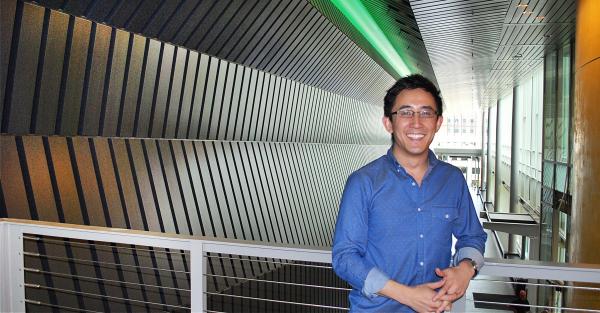The best way to fight cancer is to discover it at an early stage, which improves treatment outcomes. Of course, that isn’t easy because cancer detection thresholds based on measuring biomarkers shed by small tumors are limited.
But groundbreaking work by Georgia Institute of Technology researcher Gabe Kwong may improve the odds significantly.
In a recently published research paper for PNAS (Proceedings of the National Academy of Sciences of the United States), Kwong and his colleagues explain their development of activity-based biomarkers for early cancer detection along with a mathematical framework to predict their use in humans.
Unlike traditional biomarkers, activity-based biomarkers rely on the catalytic activity of enzymes to amplify cancer-derived signals, which allows detection of small, earlier-stage tumors. Using a class of synthetic, activity-based biomarkers, the team has comprehensively explored how detection sensitivities depend on probe design, enzymatic activity and organ physiology, and how they may be fine-tuned to reveal the presence of small tumors in humans.
“We’ve designed a system which is composed of nanoparticles, and these nanoparticles do a very interesting job inside the body once we infuse them – they find the tumor cells and then amplify a signal,” says Kwong, assistant professor in the Wallace H. Coulter Department of Biomedical Engineering and a faculty member of the Petit Institute for Bioengineering and Bioscience.
“This amplified signal is not detected locally but actually ends up filtering in the urine,” says Kwong, lead author of the paper. “So when we inject trillions of nanoparticles, each of them is amplifying this tumor signal. Furthermore, because urine is concentrated and purified from blood, we have two modes of enriching the signal. One is through this amplification at the tumor site and the other is this enrichment in the urine.”
A challenge of using blood tests for early cancer detection is that it’s kind of like trying to find a needle in a haystack. Tumors shed unique biomarkers (proteins, for example). Adult humans have on average five liters of blood. So there are tiny, early stage tumors (typically five millimeters to one centimeter in size) shedding biomarkers into a large pool of blood.
“And they don’t circulate in the blood forever. There’s a drainage system,” Kwong says. “Imagine trying to fill a bathtub with water without first plugging the drain. It’s a race, where these tumors are making these biomarkers, these biomolecules, in the blood, but the body is getting rid of them faster.”
But using the system Kwong and his team have devised, in test samples the researchers have been able to detect tumors as small as five millimeters in diameter, a size threshold that is difficult for medical imaging to achieve.
The research is part of a collective body of work that Kwong, who came to Georgia Tech last year, started at the Massachusetts Institute of Technology (M.I.T.). His co-authors of the paper (entitled “Mathematical framework for activity-based cancer biomarkers”), all affiliated with M.I.T., are Jaideep Dudani, Emmanuel Corrodeguas, Eric Mazumdar, Seyedeh Zekavat and Sangeeta Bhatia.
“It hasn’t been tested in humans yet, but this ability to amplify signals using nanoparticles is very promising,” says Kwong, who figures the system could be ready for clinical tests in humans in another three to four years.
Ultimately, the goal is to perform a more specific kind of test, “that will allow us to differentiate flavors of cancer as well as their stage. That’s where we are headed”
CONTACT:
Jerry Grillo
Communications Officer II
Parker H. Petit Institute for
Bioengineering and Bioscience
Media Contact
Jerry Grillo
Communications Officer II
Parker H. Petit Institute for
Bioengineering and Bioscience
Keywords
Latest BME News
Jo honored for his impact on science and mentorship
The department rises to the top in biomedical engineering programs for undergraduate education.
Commercialization program in Coulter BME announces project teams who will receive support to get their research to market.
Courses in the Wallace H. Coulter Department of Biomedical Engineering are being reformatted to incorporate AI and machine learning so students are prepared for a data-driven biotech sector.
Influenced by her mother's journey in engineering, Sriya Surapaneni hopes to inspire other young women in the field.
Coulter BME Professor Earns Tenure, Eyes Future of Innovation in Health and Medicine
The grant will fund the development of cutting-edge technology that could detect colorectal cancer through a simple breath test
The surgical support device landed Coulter BME its 4th consecutive win for the College of Engineering competition.








